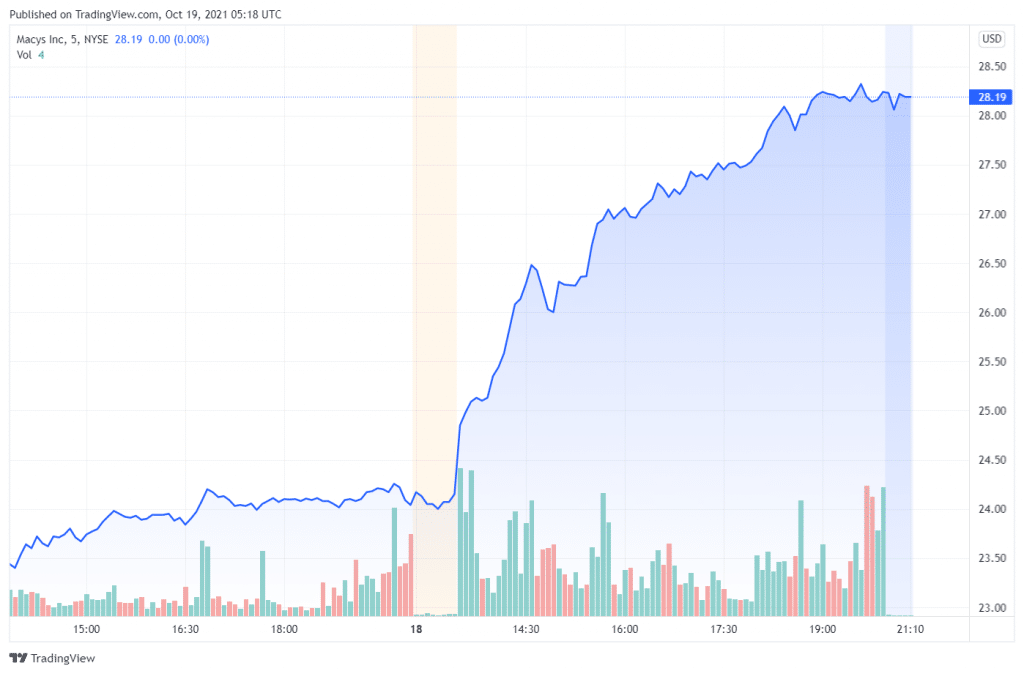Macy’s Inc. Share Forecast October 2021 – Time to Buy M?
Please note that we are not authorised to provide any investment advice. The content on this page is for information purposes only.
Shares of the New York-based American department chain Macy’s Inc. (NYSE: M) are in the green today, after closing at $28.25 on October 18th (20:49 EDT). Considering the hurdles existing in the retail landscape, Macy’s, Inc. has managed to remain afloat thanks to effective operational techniques and investments in the company’s digital capabilities. Macy’s share jumped nearly 18% today as investors speculated on what a split of the department store’s e-commerce division would entail. According to experts, shareholders increased the valuation of Macy’s as it is one of Saks’ main competitors.
Macy’s – Technical Analysis
Going by the financial statement from Macy’s Inc. the market cap of the department chain is at $8.749 billion with total assets worth $18.417 billion. Total revenue for 2020 was $18.10 billion, compared to $25.33 billion a year ago.

Moving averages for M such as Exponential Moving Average (10)(23.95), Simple Moving Average (10)(23.30), Exponential Moving Average (20)(23.30), and Simple Moving Average (20)(23.33) are pointing towards buying. Oscillators such as Relative Strength Index (14) (75.55), Stochastic %K (14, 3, 3)(69.22), Commodity Channel Index (20)(323.66), and Average Directional Index (14)(19.72) are, on the other hand, neutral.
67% of all retail investor accounts lose money when trading CFDs with this provider
Recent Developments
Macy’s shares rose on Monday, boosted by a statement in The Wall Street Journal that Saks Fifth Avenue was planning to take its e-commerce subsidiary public at a $6 billion value. On the announcement that Saks was seeking for a $6 billion value on Saks.com, Macy’s market worth soared to roughly $9 billion, more than tripling the $2 billion worth it assigned the subsidiary in March. Shareholders interpreted this as a hint that the profitability of other department retailers’ online platforms had grown as well. Although Saks’ e-commerce operation has been legally split from the holding company, customers should not perceive any significant changes in their shopping experience.
Customers frequently buy luxury products online, hence the premium department chain previously announced this year that it will split its brick-and-mortar locations from its e-commerce operation. According to reports, activist hedge fund Jana Partners urges Macy’s to follow this example. As brick-and-mortar businesses were forced to temporarily shut down due to the pandemic, shopping online has exploded in the previous year and a half. With Macy’s present market capitalization of $8.7 billion, the retail store’s share has surged by 150 per cent this year.
During the business’ Q2 results report, the company announced plans to boost investments in the coming years to improve its omnichannel possibilities. It aims to spend money on online shopping, data and analytics, technological infrastructure, and logistics.
Should You Buy Macy’s Shares?
Macy’s shares hit the highest possible level in roughly 3 years on Monday, indicating that market opinions of the company are highly dynamic as it rebounds from the epidemic. The network has hundreds of locations, comparing to only a few dozen for Saks, so separating the physical and e-commerce operations would be difficult, and management has shown little desire in doing so. However, shareholders certainly appreciate the proposition since Jana has previously been effective in influencing retail transactions.
As per Jana estimates, Macy’s eCommerce operation may be worth much more than its $7 billion market valuation. Macy’s announced in February that its eCommerce division will reach $10 billion by 2023 and that it saw itself as a digitised, omnichannel retailer, a stance shared by the company’s board of directors.
Considering Jana’s standpoint, it is understandable why Macy’s share has risen in response to the Saks announcement. Even though the $6 billion value is only a target for the meantime, it does demonstrate that public perceptions of department stores are changing and that the e-commerce websites may hold a significant portion of their valuation.






